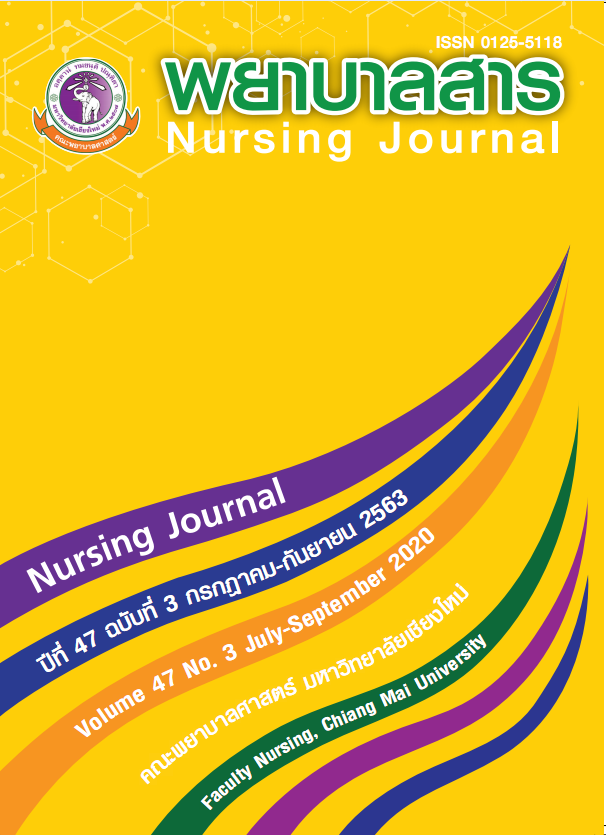Safety Leadership Competencies of Chief Nurses In Anesthesia Units
Keywords:
Competency, Safety Leadership, Chief Nurses in Anesthesia CompetencyAbstract
The objective of descriptive research was to examine safety leadership competencies of chief nurses in expert perspective. The sample of 16 experts who met inclusion criteria participated in this study. The study method consisted of three steps. Firstly, experts were asked for their opinions with open and close-ended questionnaire. Secondly, data obtained from the first step were used to develop a rating scale questionnaire which was sent back to experts for ranking and ensuring agreement on competencies. Finally, analyzed the data attained from second step using median, interquartile range, then the developed new version of questionnaire was sent to experts for consensus on the competencies.
The study found that the median of leadership competencies of the chief nurses was 4.00-5.00 and the interquartile range was 0.00-1.00. There were 6 competencies and 83 elements: (1) Safety leadership competency in reinforcing safety culture with 19 elements; (2) Safety leadership competency in teamwork for safety with 8 elements; (3) Safety leadership competency in effective communication for safety with 19 elements; (4) Safety leadership competency in safety and risk management with 16 elements; (5) Safety leadership competency in reinforcing human resources and environmental factors with 10 elements; and (6) Safety leadership competency in quality and safety reports with 11 elements.
The study indicates that competencies of safety leadership in anesthetic unit are the key competencies of transformational leadership, transactional leadership and servant leadership. Study results can be used the competency assessment guide of safety leadership in anesthetic nurse.
References
American Nurse Association. (2010). Health System Reform: Nursing’s Goal of High Quality, Affordable Care for All. Retrieved from https://www.nursingworld.org.
Clarke, S. (2013). Safety leadership: A meta-analytic review of transformational and กtransactional leadership styles as antecedents of safety behaviors. Journal of Occupational and Organiza-tional Psychology, 86 (1), 22-49.
Cooper, M. D. (2010a). Safety leadership. Retrieved from www.behavioral- safety.com/behavior based-safety-solution-center/safety-coaching-and-training/safet y-leadership. (2015). Effective Safety leadership. Retrieved from http://www.behavioural-safety.com/ articles/effective_leadership_cooper_0215.pdf. (2016). Navigating the Safety Culture Construct: A Review of the Evidence. Retrieved From http://www.behavioural-safety.com/articles/safety_culture Review.
Cooper, M. D. & Finley, L. J. (2013). Strategic safety culture road map. Franklin, IN: BSMS Continuing Care Safety Association [CCSA]. (2013). Safety Competencies. Retrieved From https://continu-ingcaresafety.ca/
Health Systems Research Institute. (2017). Multicentered study of anesthesia: related mortality and adverse events by incident reports in Thailand . Retrieved from https://www.hsri.or.th/researcher/research/new-release/detail/9540
Hospital and Healthcare Standards 4th Edition. (2018).Patient Safety Goals: SIMPLE Thailand 2018. Retrieved from https://www.ha.or.th (In Thai)
Kunzle, B., Kolbe, M. & Grote, G. (2010). Ensuring Patient Safet y Through Effective Leadership Behaviour. A Literature Review. Safety Science., 48 (1), 1-17.
Paothipchan,K.,Pinchaleaw,D., and Puttapitukpol,S.. (2015). The Relationships between Communication Skills, Safety Competency, and Patient Safety Management of Staff Nurses at an Autonomous University Hospital in Bangkok Metropolis. Journal of The Police Nurse, 7(1), 210-222. (In Thai)
Leksomboonsuk, K. (2012). The Components of the Head Nurse Competency at the Tertiary Hospital in Suphanburi Province. Thesis of Nursing Science Program in Nursing Administration, Christian University. (In Thai)
Linstone, H. (1978). The Delphi technique. In R. B. Fowles (Eds .), Handbook of Futures Research. London: Greenwood Press.
Madsalee, S. (2010). Head nurses’ work safety management, safety work behaviors and occupational hazards of perioperative nurses in general hospitals, southern Thailand. Thesis of Nursing Science Program in Nursing Administration, Prince o f Songkla University. (In Thai)
Mcmillan, T. T. (1971). The Delphi Technique. In Paper Resented at the Annual Meeting of the California Junior Colleges Associations Committee on Research and Development, Monterey, California. May 3-5.
Mohamed, S. (2017). Systematic Review on Safety Leadership: A Fresh Perspective. Retrieved from https://www.researchgate.net/publication/319377100Systematic_Review_of_Safety_Leader-ship_A_Fresh_Perspective.
Neal, A. & Griffin, M. A. (2006). A Study of the Lagged Relationships Among Safety Climate, Safety Motivation, Safety Behavior, and Accidents at the Individual and Group Levels. Journal of Applied Psychology, 91(4), 946-953.
“Nursing and Midwifery Act B.E. 1985 Revision of the Act B.E. 1997” (1997, 23 December). Royal Thai Government Gazette. 114(75), 1-9. (In Thai)
Official Nursing. (2008). Anesthesia nursing Standard. Retrieved Jan 6, 2019. Retrieved from http://www.nurseanesth.org/productdata/1339299051.pdf. (In Thai)
Poolpatarachewin, C. (2010). Future Research Techniques. Journal of Public Policy Analysis Techniques, 36 (1), 22-24. (In Thai)
Rachiwong, R. (2013). Experience of intentive care unit head nurse in managing staff’s safety. Thesis of Nursing Science Program in Nursing Administration, Chulalongkorn University. (In Thai)
Rewthong, R. (2014). The Competencies of Head Nurses at a Hospital under the Bangkok Metropolitan Administration. Master Thesis of Nursing Science Program in Nursing Administration, Christian University. (In Thai)
Schack, L. & Schack, R. (2013). Safety Leadership: A Study of the Effects of Servant Leadership Attributes on Safety Performance. A Research Project Presented to the Faculty of the School of Letters and Sciences Viterbo University.
Sonthorn, T. (2015). Relationships between self directed learning, leadership of head nurse, and performance of nurse anesthetists, general hospitals, ministry of public health, Chulalongkorn University. (In Thai)
Taylor, J. & Thomas, R. (2003). Toward measuring safety culture in aviation maintenance: the structure of trust and professionalism. International Journal of Aviation Psychology, 13 (4), 321-343.
The Healthcare Accreditation Institute (Public Organization). ( 2019). Hospital and healthcare standards 4 th edition. Nonthaburi: The Healthcare Accreditation Institute (Public Organization). (In Thai)
Thailand Nursing and Midwifery Council. (2011). Nursing and Midwifery Standard B.E. 2001. Retrieved from http://opac.lib.buu.ac.th. (In Thai)
World Health Organization [WHO]. (2016). Health topic patient safety. Retrieved from
Downloads
Published
How to Cite
Issue
Section
License
บทความที่ได้รับการตีพิมพ์เป็นลิขสิทธิ์ของวารสารพยาบาลสาร
ข้อความที่ปรากฏในบทความแต่ละเรื่องในวารสารวิชาการเล่มนี้เป็นความคิดเห็นส่วนตัวของผู้เขียนแต่ละท่านไม่เกี่ยวข้องกับมหาวิทยาลัยเชียงใหม่ และคณาจารย์ท่านอื่นๆในมหาวิทยาลัยฯ แต่อย่างใด ความรับผิดชอบองค์ประกอบทั้งหมดของบทความแต่ละเรื่องเป็นของผู้เขียนแต่ละท่าน หากมีความผิดพลาดใด ๆ ผู้เขียนแต่ละท่านจะรับผิดชอบบทความของตนเองแต่ผู้เดียว






